Archive for the ‘holocaust’ Tag
The Question of ‘Work-Life’ Balance

Photo: Salvador Dali Museum
Kate Winslet’s film ‘Lee‘ about the life of American photographer Lee Miller, which premiered at TIFF in Toronto last September, is due to arrive in cinemas and on Sky sometime this quarter or thereabouts.
The movie is based on the biographical ‘The Lives of Lee Miller‘ by her son Anthony Penrose, who I had the pleasure of meeting when it came out in 1988 and I was reviewing the book – he gave me a tour of Farley Farm in Sussex (where the Lee Miller Archives are now based, it had been Lee and Roland Penrose’s home, which then was passed on to Anthony and his late wife, who together welcomed me warmly to their cosy kitchen). Anthony later pulled various prints out of plan chests to show me. The moment I particularly remember relates to Holocaust Memorial Day which was this weekend. Lee, working as a war correspondent for Vogue, was among the first to enter Dachau and Buchenwald concentration camps. She felt she had to telegraph to the editor this message once she had sent back her photos: “I IMPLORE YOU TO BELIEVE THIS IS TRUE!” Anthony recounted to me that his mother had told him in relation to these pictures that the one thing she could never forget, more than the sights, was the smell.
Following the bijou ‘You Will Not Lunch In Charlotte Street Today‘ exhibition of her work which closed a week ago at the handsome TJ Boulting building in London’s Fitzrovia, I visited another Lee Miller show at Brighton Museum, ‘Lee Miller: Dressed‘ (also well worth a visit – 59-minute train from London, closes 18th Feb). It explores Lee’s life through clothes, given that Lee was a celebrated model for the likes of Vogue, becoming a fashion photographer in her own right after training with Man Ray in Paris, the clothes lens makes perfect sense. The exhibition was prompted by the recent discovery of boxes of Lee’s clothes in the attic at Farley Farm, including a number of items by top European couturiers.
A quotation caught my eye (and imagination) near the exit:

When I fired up LinkedIn this morning I noticed a post by Fanatics Live CEO Nick Bell about work-life balance, prompted in part by a video of Amazon’s Jeff Bezos on the subject. My late mentor, veteran documentarian and polymath Roger Graef, was always a brilliant help and support but work-life balance was arguably his one blind spot, he was a ferociously hard worker who rarely seemed to switch off. It’s a fascinating and nuanced issue, and my jury is still out on whether Bezos’ argument – that it’s actually a work-life circle – and Nick’s – that being happy at work makes you a better spouse and parent – is on point or has an underlying post-rationalisation. As another Jeff (Goldblum) says in another movie, ‘The Big Chill‘:
“Michael: Don’t knock rationalization! Where would we be without it? I don’t know anyone who could get through the day without two or three juicy rationalizations. They’re more important than sex.
Sam: Ah, come on. Nothing’s more important than sex.
Michael: Oh yeah? Ever gone a week without a rationalization?”
I directed a film years ago about creative thinking and I remember a line from it which was broadly: “No one on their death bed ever thought ‘I wish I’d spent more time in the office’.” Perhaps the starkest factor: you can’t ever get back time with your children once it’s passed.
So I find Lee’s reflections resonant – why not be more focused on and bold with our ideas, our physical being (less time in our heads) and our love in its myriad forms (romantic, parental, familial, environmental, spiritual, for our fellow human-beings…)?





Let’s Hear It for Audio
With the announcement of the BAFTA Best Film nominations last Thursday as always there was a notable omission. Jonathan Glazer’s ‘The Zone of Interest‘ is by a country mile the best movie of the year, in what is a pretty strong year. It carries a credit to my late Film4 colleague Sue Bruce-Smith, who sadly passed away way too young early in 2020, indicating how long it’s been in the making (Glazer optioned the not-yet-published, eponymous Martin Amis source novel in 2014). That decade of development resulted in a highly original, brilliantly crafted, important film.
I’m currently working on an Auschwitz documentary with journalist Martin Bright with a not dissimilar story so was intrigued to see how Glazer dealt with the two spaces – the Commandant’s house and the concentration camp next door. What is most striking about the film is how it puts so much emphasis on the audio of this premium audio-visual medium and portrays the death camp primarily through sound, enabling the director to convey both spaces simultaneously.
From the moment at the start of the film when Commandant Höss returns from a bucolic picnic to his family home adjacent to the camp a low rumbling subtly enters the soundtrack, the sound of the furnaces on the other side of the wall efficiently burning up bodies round the clock. As the film goes on, life on the domestic side of the wall with its pretty flower garden and idyllic countryside is punctuated by gun shots, ferocious barking, occasional screams and every so often a steam train pulling in (loaded with we know what). Gradually these hellish sounds render the inhabitants of the domestic space soul-sick, from the young son to the Commandant himself, who pukes on the stairs he eventually descends into the blackness of eternal damnation.
Before any pictures, the movie opens with a (long) couple of minutes of music over a dark grey screen – or rather ‘music’ as it is more like composed noises, deeply disturbing. The film ends in similar style, with distorted choral voices cutting through diabolical noises. The music composition and sound design are defining and brilliant, indicating why the picture picked up both the Grand Prix at this year’s Cannes Film Festival and the Soundtrack Award.
Audio is often overlooked or underused in film, TV and audio-visual media. When we made ‘MindGym‘, winner of the first ever BAFTA for Interactive Entertainment, “brilliant sound” was one of the key principles we kept on a sticky note on the office wall throughout production. In ‘Screen International’ Glazer described the movie’s audio as “the other film” – “arguably, the film”.
Johnnie Burn and Audio Mixer Tarn Willers have been nominated for the Best Sound BAFTA. A remarkable Sound Designer, Burn compiled an extensive list of pertinent events at the death camp alongside witness testimonies, from which to draw realistic sounds for an authentic sound library deployed on the film. They used a detailed map of Auschwitz to calculate the distance and reverberation of the sounds.
‘The Zone of Interest’ is in some cinemas now but is officially released in the UK on 2nd February (and on 9th February in Poland where it was shot, primarily at Auschwitz). Not to be missed.
First day of the year
That back to school feeling never really fades. The first day back at work every year is a bit of a challenge however much you like your work. Despite the promise of new beginnings, fresh slates, new directions the contrast with hanging out with family and friends, enjoying entertainments, walks, sleeping in is never easy.
The Christmas holidays are synonymous for BAFTA voting members with the first round of the Film Awards voting. This year – a very good year – IMHO was crowned by the astonishing The Zone of Interest directed by Jonathan Glazer. Loosely based on a novel by Martin Amis, it tells the story of the Holocaust at Auschwitz through a domestic drama set in the commandant’s house just over the wall from the death camp. The acting is flawless, the sound design a revelation and the direction perfectly judged. It has clearly been a long time in the making as I spotted in the credits my lovely old Channel 4/Film 4 colleague Sue Bruce-Smith who very sadly passed away way too young in 2020 in Dublin.
Untimely death and the Holocaust both bring us back to a quotation from Anne Frank which for me gives a clue as to where to start the new year of work…
“How wonderful it is that nobody need wait a single moment before starting to improve the world.”
Anne Frank in Anne Frank’s Tales from the Secret Annex: A Collection of Her Short Stories, Fables and Lesser-known Writings
Given that, hidden in an Amsterdam attic with the threat of violence and death all around her, she was facing something far more challenging than a new year of work and making a living, her positive perspective is very striking and inspiring.
So the new work year is beginning for me today, by happy coincidence, with a documentary film about witnessing the Holocaust from close quarters through the barbed wire. I have been working on the project for a couple of years with journalist Martin Bright and it feels like this is its year. The release of The Zone of Interest can only help as the stories are very complementary.
For this project and others this year the other words I am going to keep in mind are these from the American author William Faulkner…
“You cannot swim for new horizons until you have courage to lose sight of the shore.”
William Faulkner
Having the courage to try new things and realising that exciting new work which makes a real difference in the world can begin this second is my suggestion for where to begin…
Other thoughts on the best of cinema in 2023 can be found here
VE Day Walk supplementary
These images relate to VE Day 75 – The Walk
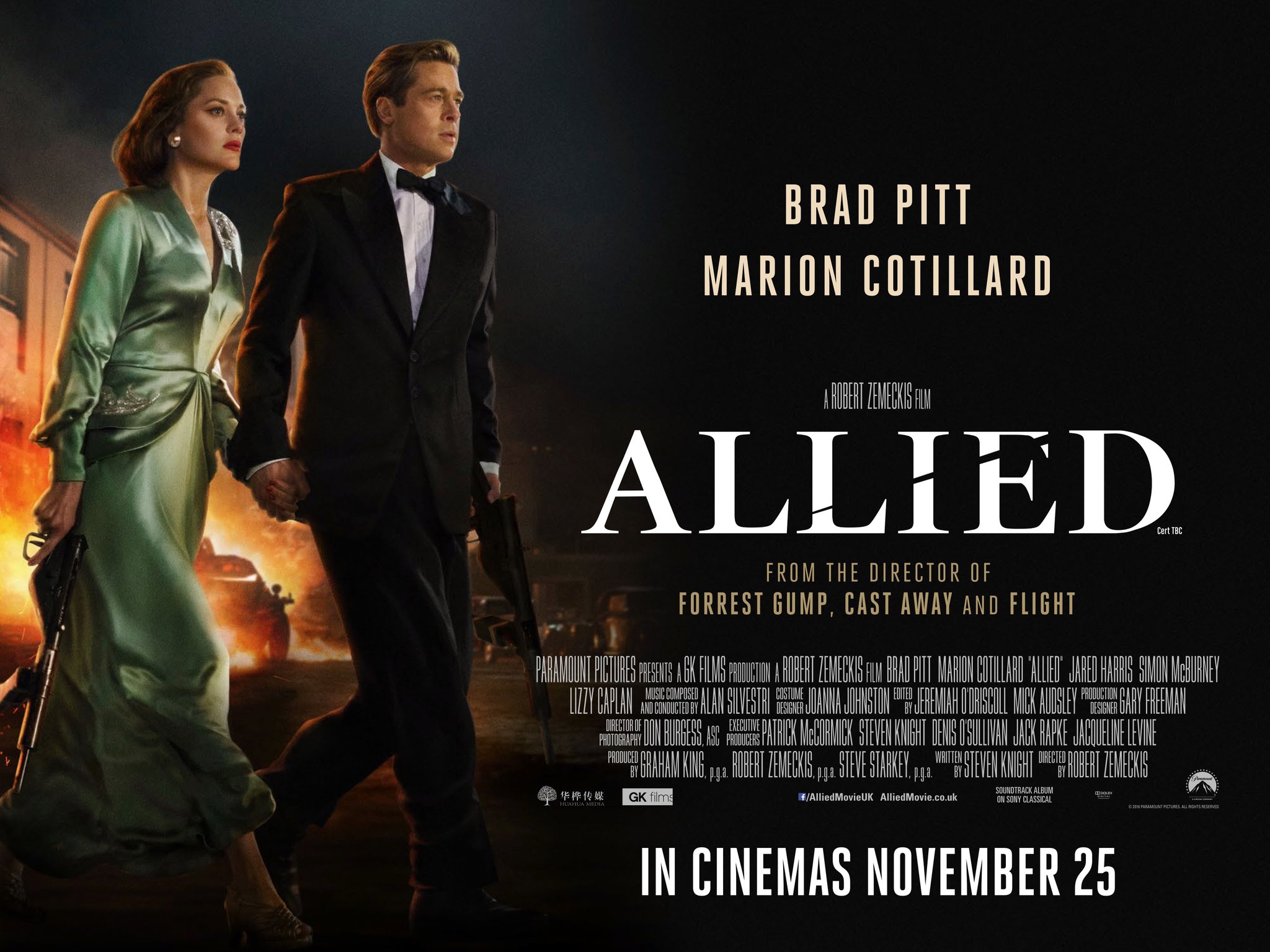

Brad Pitt & Marion Cotillard at the Hampstead location

Nicholas Winton

Nicholas Winton

Liam Gallagher

Lee Miller by Man Ray

Lee Miller goes to war as an accredited US war correspondent

Lee in Hitler’s bath tub, Munich – the day she photographed Dachau – by David Sherman

Orwell’s wartime broadcasts

Eileen Maud Blair – Orwell’s wife
VE Day 75 – The Walk

Beginning of my VE day walk – a lone hint of celebration on our street – East Finchley, London N2

Coronavirus has stopped normal access to the commonwealth war graves in St Pancras & Islington cemetery

The commonwealth war graves in St Pancras & Islington cemetery earlier in the lockdown (before they closed the cemeteries)

I’m sitting just beneath Emile Guillaume’s La Délivrance known locally as The Naked Lady – it’s a WW1 memorial but it is opposite the flat where my great-uncle Bruno lived, a concentration camp survivor & refugee from Leipzig Germany, so its WW2 victory for me

Flowers for children VE Day 75, Henly’s Corner

The clock tower memorial to WW1 & WW2 at Golders Green with its distinctive blue

WW2 poetry Keith Douglas in flower garden at Golders Hill – wisteria no hysteria, stiff upper lip
Comment: unicornsalmost
This Sunday, on @bbcradio3 : Unicorns, Almost – a play about the life and poetry of Keith Douglas https://www.bbc.co.uk/programmes/m000j2bn

Hampstead war memorial to both world wars – a few hundred yards from where I was born, overlooking all of London

Film location of ‘Allied’ movie with Brad Pitt & Marion Cotillard set during WW2

Film location of ‘Allied’
I met a family sitting out on their front steps down the road from here, told them what I was doing and they pointed me to…

Nicholas Winton saved 669 Jewish children from the Nazis when based in this house in Hampstead

Liam Gallagher‘s RAF roundel window at his old place in Hampstead

Photographer Lee Miller‘s house Hampstead – she photographed WW2 for Vogue magazine including the liberation of Dachau & Hitler’s bathtub in Munich

My dad remembered vividly a doodlebug V1 exploding in the corner of this pond near his childhood home – I never walk by without thinking of him Hampstead Heath, VE day 75

George Orwell‘s house – his wife Eileen O’Shaughnessy worked at the Ministry of Information during WW2 (in the censorship department) in Senate House, University of London & he famously used it as the model for the Ministry of Truth in 1984 – Orwell was in the Home Guard & broadcast for the BBC
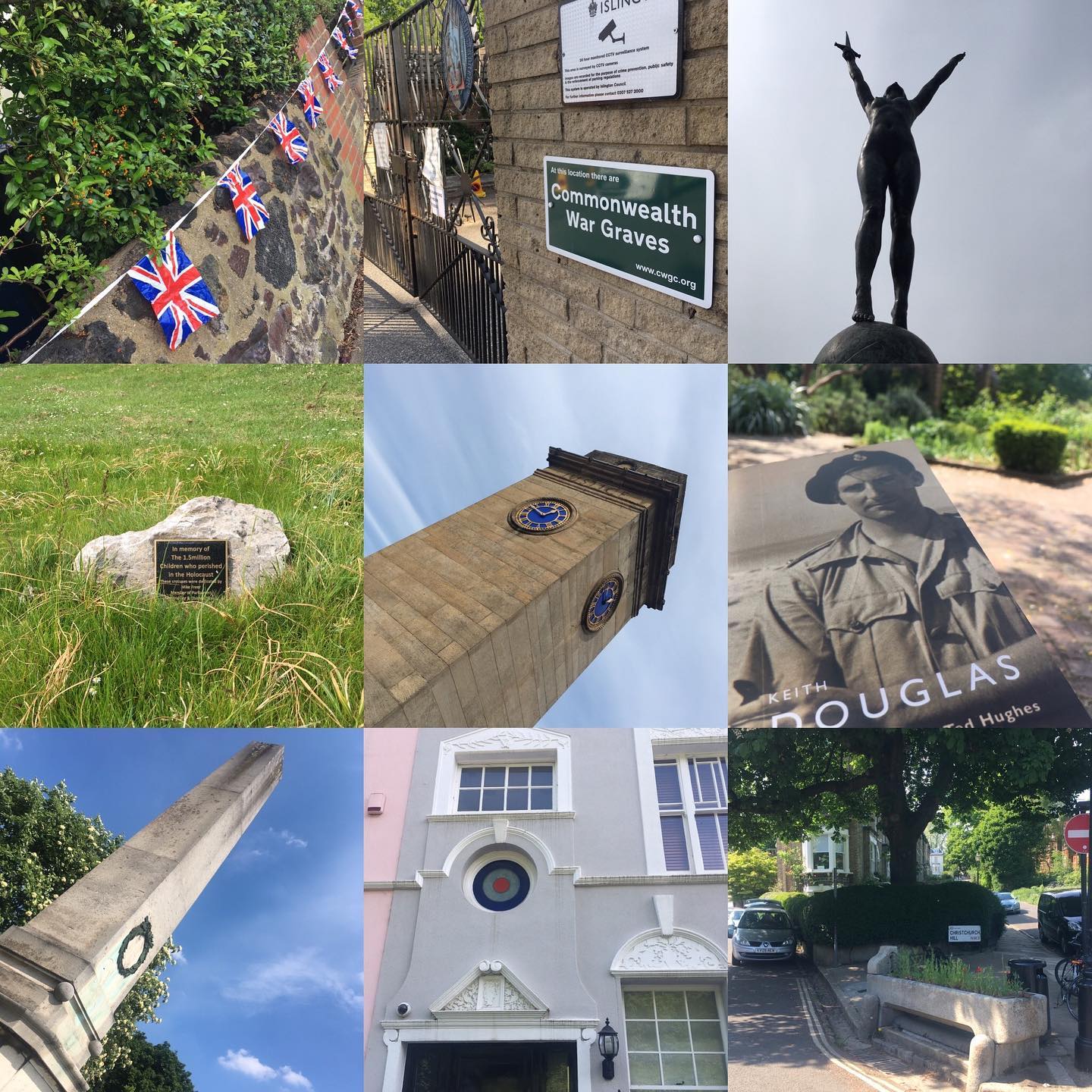
That’s the VE day 75 walk done – 9 hours, 24,600 steps, good fun
VE Day 75

8th May 1945, Trafalgar Square
The current situation of lockdown under threat of a deadly viral enemy is as close to war as my generation has ever come which makes it a most resonant time to celebrate this landmark VE Day, the 75th.
My most memorable VE day to date was one spent in Bangor, Co. Down, N. Ireland when my wife was working on the BBC’s live coverage of the event which involved the lighting of a string of lanterns right round the British coast. To help her manage the day, with a very demanding, experienced and alcoholic director, I looked after one of the main contributors, a charming old fella from Belfast who had survived the Belfast Blitz of 1941. I spent the day hanging out with him, chatting and making sure he felt looked after. He was interviewed in the evening by John Cole.
Today’s VE day I marked with a themed walk, made up last minute, partly on the fly. I came up with the idea while sitting in the garden in the early morning sunshine. By 9am I was on the road. 9 hours and 24,600 steps later I returned home.
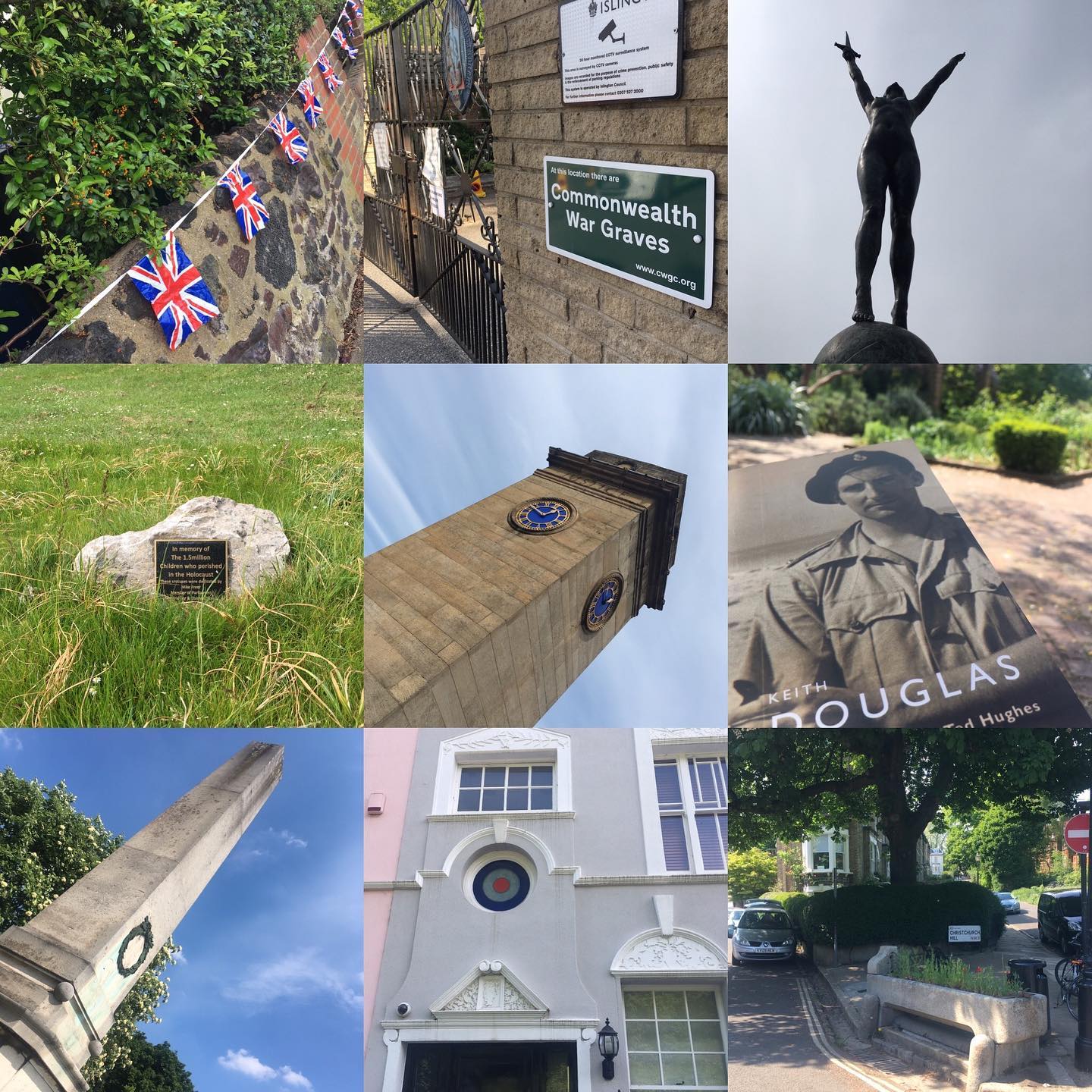
I’ll publish the details of the walk tomorrow – it ranged from photographer Lee Miller’s house to Liam Gallagher’s RAF roundel window, from the location of a Brad Pitt war movie to a tribute to the 1.5 million Jewish children killed in the holocaust.
Half way I stopped to read some of Keith Douglas‘ poetry, a WW2 poet stationed largely in North Africa. He died shortly after D-Day at the age of just 24. The line
but time, time is all I lacked
from the last poem in the volume (a selection by Ted Hughes) seemed to sum up his artistic life. There’s a radio play about him on Radio 3 on Sunday (10th May) at 7.30pm called ‘Unicorns, Almost‘ by Owen Sheers.
I began the day by sharing an unpublished poem by Edmund Blunden entitled ‘V Day’. it’s in the manuscript collection of the Imperial War Museum. It concludes with the line:
We have come through.
which seems very apposite and inspiring for these strange days.

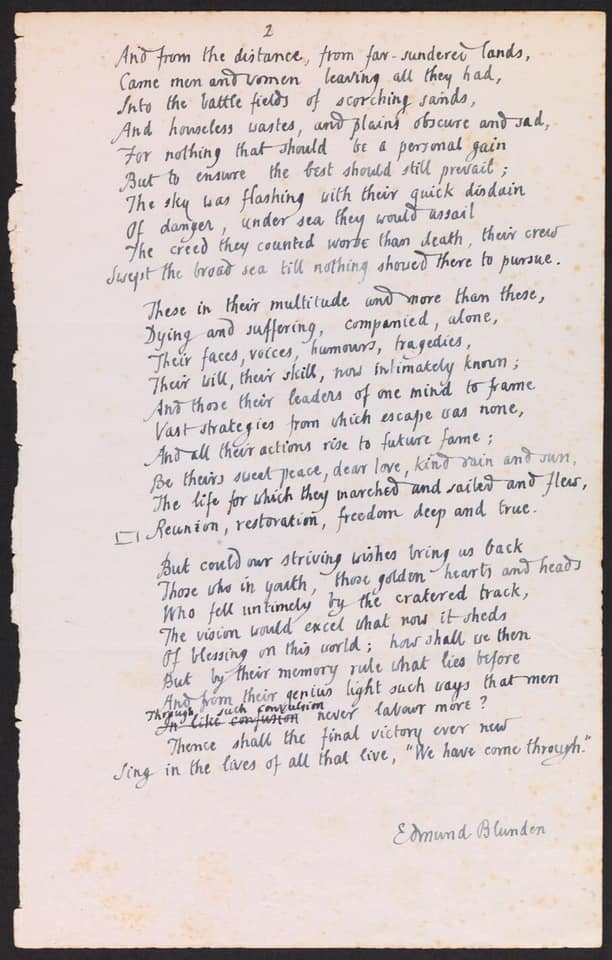

Edmund Blunden – a WW1 poet who was still writing in 1945

Keith Douglas
Combatting Corona Quotes
“It’s in your hands how you look at it. I still have hopes and dreams. I don’t know when we will get back to normal and I don’t really care because I’m living right now. I’m making the most of it. I’m going to do my best to have a better future and an even better day tomorrow.”
Nadia Nadim, footballer, Paris Saint-Germain (fled Afghanistan aged 12)

“Everything can be taken from a man but one thing: the last of the human freedoms—to choose one’s attitude in any given set of circumstances, to choose one’s own way.”
Viktor Frankl, Man’s Search for Meaning
4 places worth visiting in Vilnius
I was in Lithuania last week working on ESoDoc, a workshop and development space for social documentaries. The last time I worked on it was back in 2010 in Tenno, Northern Italy. We were based this time in the National Library of Lithuania and between sessions I adopted my favourite role of flâneur.
1. The National Library of Lithuania

Its classical grandeur dates back to 1919, the year after Lithuanian independence from Germany and Russia. It sits next door to the modern parliament building which stems from Lithuania’s second independence day, 11th March 1990, the first of the Baltic States to break away from the USSR.

An important emblem of Democracy
The books in the main atrium are cleverly decorated with black covering on their spines to create the faces of various key literary/historical figures.

2. Knygynas VAGA book shop

Knygynas VAGA book shop
A book shop where you can get strudel – what’s not to love? Really enjoyed hanging out here. Had to speak German as the strudel lady couldn’t speak English. We struggled a bit trying to identify pumpkin.
I picked up two Lithuanian novels in English here: Cold East by Gabija Grušaitė (“A new voice that disrupted Lithuanian lierature”) and Salt to the Sea by Ruta Sepetys (a Lithuanian American, author of the very successful debut Between Shades of Gray).
3. The Republic of Užupis
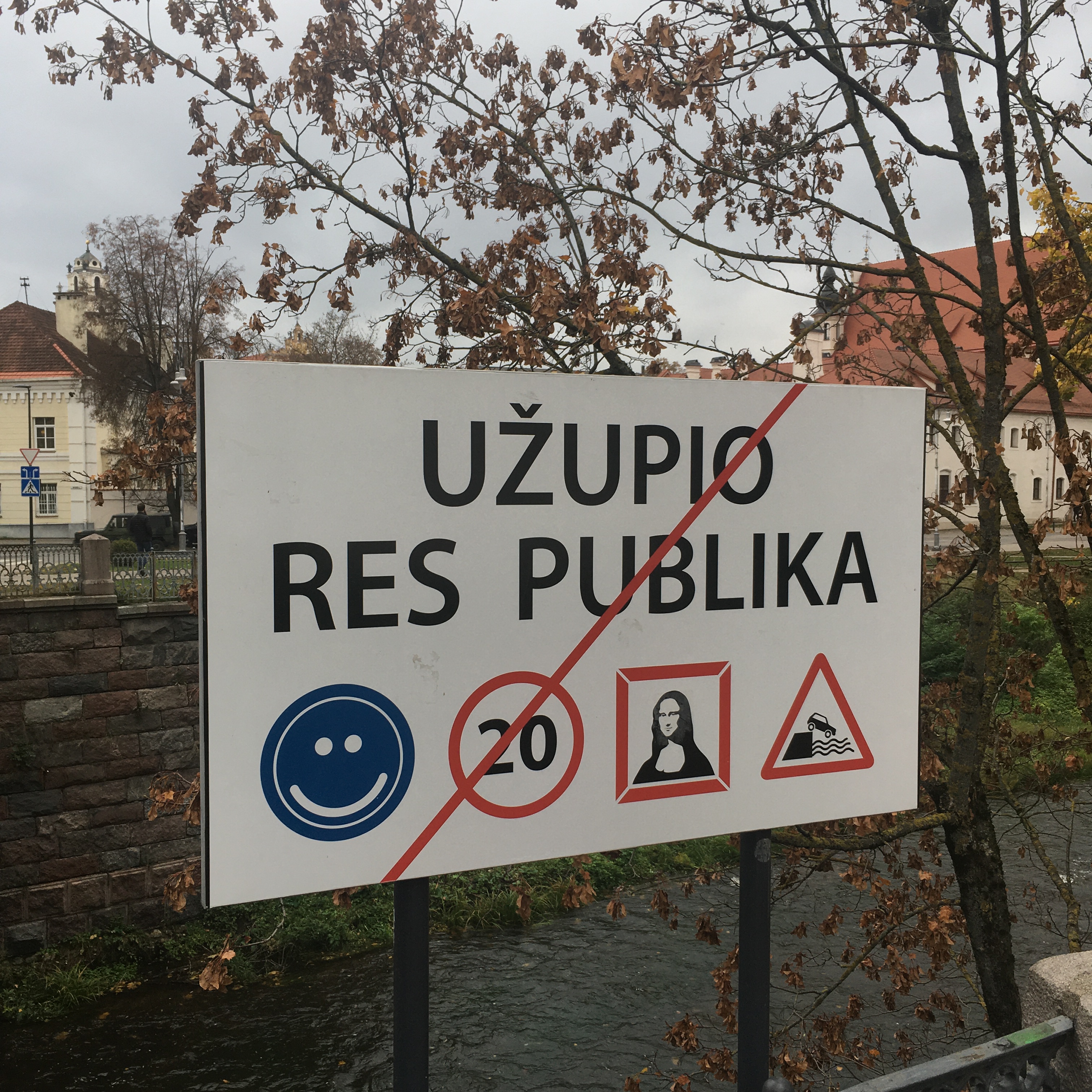
Border of the Republic
A hippy, bohemian quarter a bit like Chrisiania in Copenhagen. The name means “other side of the river” – it sits in a loop on the far side of the Vilnia. It declared itself a republic in 1998 – it has its own flag, currency, constitution and ambassadors (including my friend author Charlie Connelly who it turns out is their UK ambassador – I believe drink may have been involved in precipitating this appointment). They change the flag every season – it is currently blue for Winter.
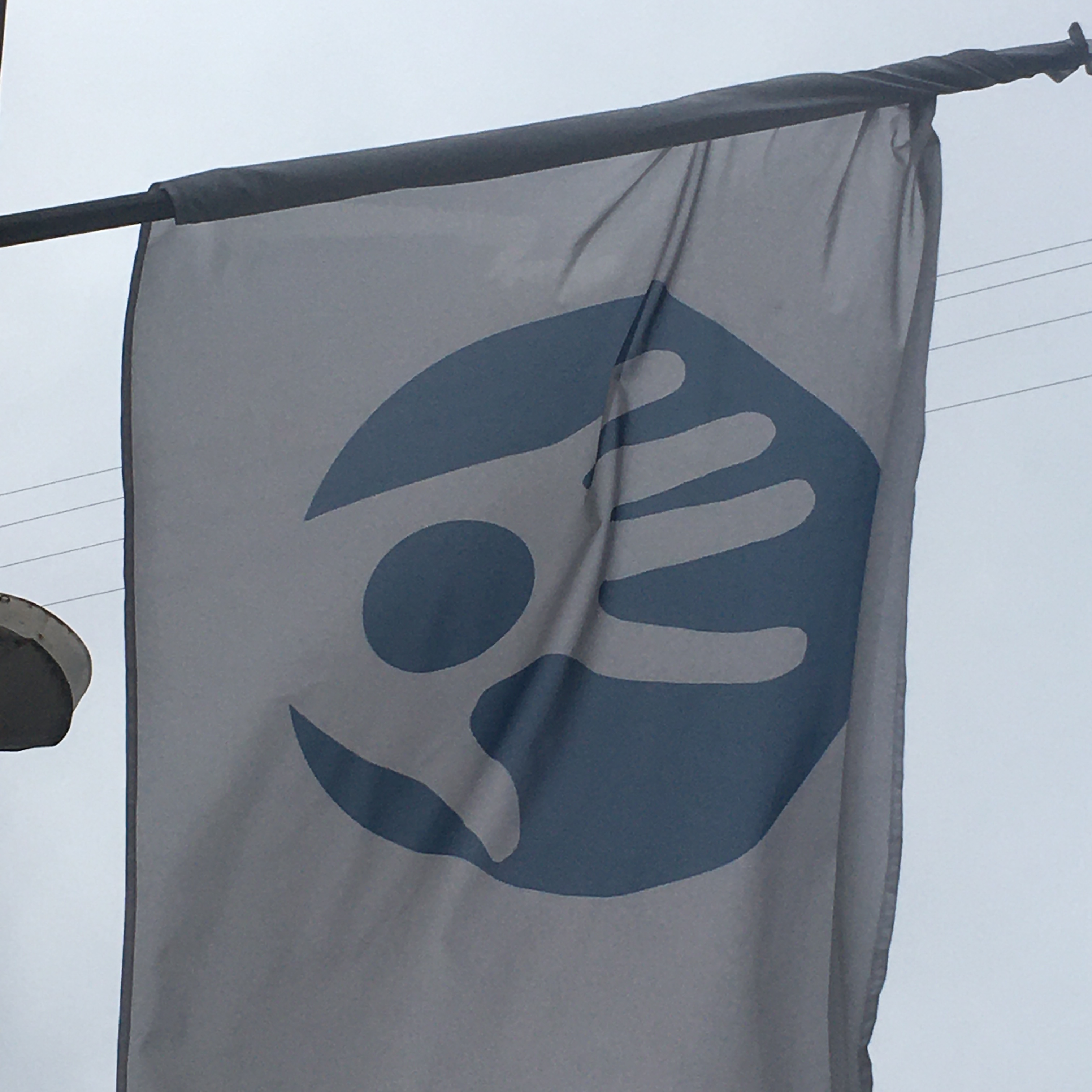
Winter – blue, Spring – green, Summer – yellow, Autumn – red
It began life in the 16th century as a mainly Jewish area. WW2 reduced the Jewish population of Vilnius from 58,000 to 2,000. The Soviets then destroyed the cemetery up the hill from Užupis.
Now it’s mainly an artistic area, albeit a gentrified one at this point. Between the War and Independence in 1990 it was the realm of the homeless and prostitutes, very neglected. Needless to say, the artists moved in and made it cool and meaningful. Gotta love the artists. It still has a certain charm and some good street art. It seems to have been set up as an artistic provocation, to prompt important conversation. The Republic’s independence day is 1st April.
4. The Ghetto

Site of the Great Synagogue
Vilnius had two ghettos during the Nazi period – the small and the large. They both got liquidated (or “liquidized” as one Lithuanian tourist website has it) by Nazis and Lithuanian police shooting tens of thousands of Jews in the forests around the city. Above is the site of the Great Synagogue where 3,000-5,000 worshippers could be accommodated. It was damaged in the War but the Soviets were the ones who finished the job in the mid-50s, turning a magnificent building into an architecturally insignificant kindergarten (in the background above). I had an interesting chat with a Polish woman at this sign. She told me how poor all the Poles were before the war. Just like the citizen of Neulengbach in Austria (location of Egon Schiele’s studio) who told me how poor the Austrians were.

Commemorating the inhabitants of the ghetto
Despite these dark shadows I enjoyed the ghetto area in its autumn colours. I could sense the people. I sat in an open area reading a Lew Archer novel and sucking up the vibes. The city has peppered the area with monochrome murals of the former citizens, with QR codes linking to some basic information. I wonder what this fella would have made of QR codes…

QR codes schmoo R codes
Tigress

While it was very sad to hear of the death of Judith Kerr this week, it also felt like the rounding off of a life well lived. To come from flight (in 1933) from the Nazis and the Holocaust in Germany, Poland, France and across Europe (which went out to vote the day after her passing) to a constructive, hopeful and beautiful body of work which gives delight to millions is a story and a half.
I had the pleasure of appearing with her on BBC Radio 4’s ‘Woman’s Hour’, talking about fathers reading to their children. Prior to entering the studio I’d forgotten that the programme was live so it really helped having a calm atmosphere engendered by Judith and Jenni Murray, the host. I can’t recall much about the conversation other than it went well, felt coherent and fluent, not stressful. And Judith was a thoroughly inspiring person.
Of course I read ‘The Tiger Who Came to Tea’ with my boys. She kindly signed their copy after the recording at Broadcasting House.
I have a vague memory of people looking for a historical analogy in it, like the Tiger stood for the Nazis or the Gestapo or something, “It’s about the rise of Hitler, right?” “No” she said “it’s about a tiger. Who comes to tea.”
That Judith Kerr now stands widely as being about turning adversity to living fully, being constructive and defeating the forces of darkness with hope and humanity is as it should be. The family, though surprised, take the Tiger in their stride and find a joyful, united solution to the problems it causes.
I am writing this in the garden of Keats’ house in Hampstead. Up the road in Downshire Hill, opposite the house of Lee Miller and Roland Penrose, is the home of Fred and Diana Uhlman. I met her many years ago to speak about her husband’s work as an artist and their joint role as catalysts of the London art scene before and after the Second World War. Fred came to London in 1936 and became the centre with Diana of a network of artists on the run including Oskar Kokoschka (who followed in the wake of Egon Schiele). This whole area became a home to artists escaped from Nazi tyranny. Judith was the widely admired standard bearer for art and culture’s triumph over the dark side.

The Artist Who Came To London (acquired this week from Black Gull book shop, East Finchley)
Do the Right Thing: Google v Morality
OK Google, did the Holocaust happen?

 Comments (1)
Comments (1)




